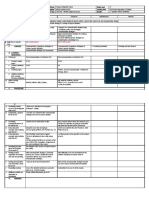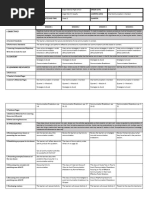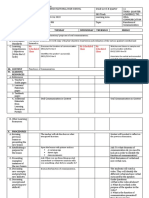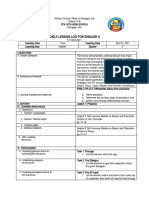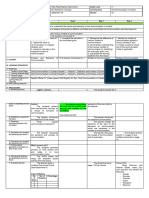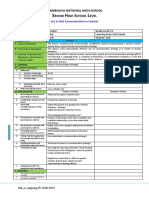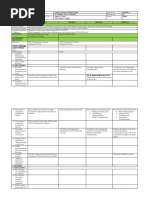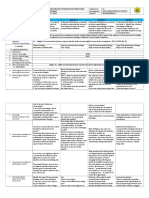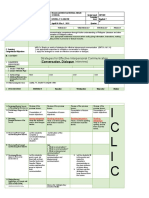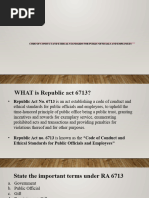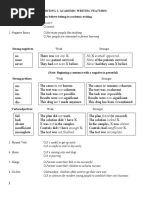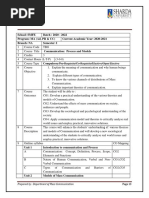0 ratings0% found this document useful (0 votes)
20 viewsOc LP 2
Oc LP 2
Uploaded by
May Dee GrefalCopyright:
© All Rights Reserved
Available Formats
Download as DOCX, PDF, TXT or read online from Scribd
Oc LP 2
Oc LP 2
Uploaded by
May Dee Grefal0 ratings0% found this document useful (0 votes)
20 views3 pagesOriginal Title
OC LP 2
Copyright
© © All Rights Reserved
Available Formats
DOCX, PDF, TXT or read online from Scribd
Share this document
Did you find this document useful?
Is this content inappropriate?
Copyright:
© All Rights Reserved
Available Formats
Download as DOCX, PDF, TXT or read online from Scribd
Download as docx, pdf, or txt
0 ratings0% found this document useful (0 votes)
20 views3 pagesOc LP 2
Oc LP 2
Uploaded by
May Dee GrefalCopyright:
© All Rights Reserved
Available Formats
Download as DOCX, PDF, TXT or read online from Scribd
Download as docx, pdf, or txt
You are on page 1of 3
GRADE 1 to 12 Grade Level: 11
DAILY LESSON LOG Learning Area: ORAL COMMUNICATION IN CONTEXT
Time allotment: 2 HOURS PER DAY Quarter: 1
Time and Schedule: 7:45 – 9:45 (Monday and Wednesday)
I. OBJECTIVES June 18, 2018 (Monday) June 20, 2018 (Wednesday)
A. Content Standard The learner understands the nature and elements of oral communication.
B. Performance Standard The learner designs and performs effective controlled and uncontrolled oral communication activities based on context.
C. Learning Competencies EN11/12OC-Ia-4: Distinguishes the unique features of one communication process EN11/12OC-Ia-6: Use various strategies in order to avoid communication breakdown.
from the other.
EN11/12OC-Ia-5: Explain why there is breakdown of communication.
At the end of the discussion, the students should be able to: At the end of the discussion, the students should be able to:
Specific Objective/s identify the function of communication in the situations distinguish the importance of verbal and nonverbal communication
describe the process of communication by identifying its role components. identify the nonverbal communication commonly used by Filipinos
II. CONTENT Functions of Communication Verbal and Nonverbal Communication
Features of Effective Communication
Barriers to Communication
III. LEARNING RESOURCES
A. References
Teaching Guide: p. 3-4 p. 10
Materials: Textbook, laptop, projector Textbook, laptop, projector
Textbook Pages: pp. 5-9 p. 4
Additional Materials from Learning Resource Portal
B. Other Learning Resources Slideshare.com
IV. PROCEDURES
A. Reviewing previous lesson or presenting Call students to review on the previous lesson – Models of communication Review on the previous lesson – Barriers of communication
the new lesson
B. Establishing a purpose for the lesson Present videos to show interaction of the process of communication. Explain to the class that communication consists of verbal and nonverbal
communication.
C. Presenting examples/ instances of the new Summarize the concepts. Call students to give sample of verbal communication.
lesson Call students to present their assignment to the class about examples of
communication process.
D. Discussing new concepts and practicing Discuss verbal communication and the features learners have to adopt when
new skills # 1 communicating verbally.
E. Discussing new concepts and practicing Then, ask them again: Who, in your opinion is a good communicator? Why do Present pictures of gestures to the class.
new skills # 2 you think he/she communicates well? Have them give their interpretation upon seeing those gestures.
Process their answers to the class. Then, introduce nonverbal communication
Present the features of communication.
F. Developing mastery (leads to Formative Connect to the next topic by asking : If a speaker follows all the features in
Assessment 3) effective communication, will every communication activity always be
successful?
Elicit answers from the class.
Discuss the various barriers to communication.
G. Finding practical application of concepts Let the students proceed to their group. Ask: How did nonverbal communication help in our everyday communication?
and skills in daily living Have them answer Exercise III on page 7.
H. Making generalization and abstractions Call students to share their learning about the discussion. Call students to share their learning about the discussion.
about the lesson
I. Evaluating learning Let them answer the following: Let them do Exercise 5 on page 11.
Using the diagram presented on the process of communication,
describe each by identifying its role in communication.
J. Additional activities for application or Using the semantic web, let the students give the fundamentals of
remediation communication.
V. REMARKS
VI. REFLECTION
A. No. of learners who earned 80% in the
evaluation
B. No. of learners who require additional activities
for remediation who scored below 80%
C. Did the remedial lessons work? No. of learners
who have caught up with the lesson
D. No. of learners who continue to require
remediation
Prepared by:
You might also like
- Rhythm To RecoveryDocument254 pagesRhythm To RecoveryGiacomo Maria Magi100% (8)
- DLL - Oc Week 1Document3 pagesDLL - Oc Week 1Ziana Ross Hampac80% (5)
- Oral Communication DLL Week 3Document4 pagesOral Communication DLL Week 3raul.ladaojr100% (1)
- Oral Com DLL Week 10Document3 pagesOral Com DLL Week 10SHERYL GARCIA100% (1)
- Teaching Across Proficiency LevelsDocument24 pagesTeaching Across Proficiency LevelsPhnita Kulsirisawad100% (2)
- DLL UcspDocument3 pagesDLL UcspAngelica OrbizoNo ratings yet
- Oc LP 1Document3 pagesOc LP 1May Dee GrefalNo ratings yet
- Oral CommunicationDocument2 pagesOral CommunicationHaidz GodoyNo ratings yet
- Grades 1 To 12 School Grade Level: I. ObjectiveDocument2 pagesGrades 1 To 12 School Grade Level: I. ObjectiveMarisselNo ratings yet
- 1. Oral Com August 5-9, 2024Document3 pages1. Oral Com August 5-9, 2024Marilyn Delos SantosNo ratings yet
- Oral Comm DLL Q 1 WK 4Document6 pagesOral Comm DLL Q 1 WK 4Mary Lyn N. MagpayoNo ratings yet
- Nature and Elements of CommunicationDocument3 pagesNature and Elements of Communicationirish bayonetaNo ratings yet
- DLL FormatDocument5 pagesDLL FormatAnthony ChanNo ratings yet
- LS1E Module 3 Functions of CommunicationDocument6 pagesLS1E Module 3 Functions of CommunicationBernard BanalNo ratings yet
- I ObjectivesDocument4 pagesI ObjectivesAngel Mar CasañaNo ratings yet
- Week 3Document3 pagesWeek 3April Mae JacobNo ratings yet
- Week 1Document3 pagesWeek 1April Mae JacobNo ratings yet
- DLL Oral Comm Week 1Document8 pagesDLL Oral Comm Week 1Ja LascanoNo ratings yet
- Mil DLL Lesson 1Document4 pagesMil DLL Lesson 1Glenda QuinzonNo ratings yet
- Castillano DLP in English 11Document3 pagesCastillano DLP in English 11Jerome CastillanoNo ratings yet
- Daily Lesson Log: The Learner... The Learner... The Learner..Document2 pagesDaily Lesson Log: The Learner... The Learner... The Learner..Christian Joy Magno OlarteNo ratings yet
- Oral Com. q1 Week1Document3 pagesOral Com. q1 Week1Nonie Ann GalangNo ratings yet
- I - Objective: The LearnersDocument2 pagesI - Objective: The Learnersmr26sam1994No ratings yet
- Daily Learning LogDocument2 pagesDaily Learning LogDiane Gida MatiraNo ratings yet
- Strategies For Effective Interpersonal Communication (Conversation, Dialogue, Interview)Document3 pagesStrategies For Effective Interpersonal Communication (Conversation, Dialogue, Interview)Dhaeyang Rosales-Tumitay LoreteNo ratings yet
- Dll-Oral Communication Q1-W3Document5 pagesDll-Oral Communication Q1-W3Marie JavierNo ratings yet
- DLL-Q1-Week-3Document5 pagesDLL-Q1-Week-3joyfaith.mendozaNo ratings yet
- Oral CommDocument3 pagesOral CommCatherine CallejaNo ratings yet
- DLL Oral ComDocument6 pagesDLL Oral Comrahib l. makasimbualNo ratings yet
- Grade 9 Week 1 Q3Document3 pagesGrade 9 Week 1 Q3Aristotle TomasNo ratings yet
- DLL ObservationDocument3 pagesDLL ObservationSire Flayo Aspen ThislewaiteNo ratings yet
- April 2nd weekDocument5 pagesApril 2nd weekApple Janine CamposNo ratings yet
- OCC DLL-types of SpeechDocument3 pagesOCC DLL-types of SpeechANA MAE MACAYA100% (1)
- DLL Oral Comm Q2 Week 4Document3 pagesDLL Oral Comm Q2 Week 4Marichu Fernandez100% (2)
- DLL Week 2Document5 pagesDLL Week 2rodchiel.gensayaNo ratings yet
- 1st Week AugDocument5 pages1st Week AugMALOU ELEVERANo ratings yet
- Oral Communication DLL Week 1Document4 pagesOral Communication DLL Week 1raul.ladaojrNo ratings yet
- Mambuaya National High School Enior IGH Chool Evel: DLL in Oral Communication in ContextDocument2 pagesMambuaya National High School Enior IGH Chool Evel: DLL in Oral Communication in ContextCydryl A MonsantoNo ratings yet
- DLL CW Week4Document9 pagesDLL CW Week4Nino JimenezNo ratings yet
- Oc Week 1 DLL - F. DuncabDocument4 pagesOc Week 1 DLL - F. DuncabFatima DuncabNo ratings yet
- Grade 11 ORAL COMMUNICATION DLLDocument3 pagesGrade 11 ORAL COMMUNICATION DLLSHAIRA MAY GONo ratings yet
- wk5 - Oral Comm DLLDocument2 pageswk5 - Oral Comm DLLMay Ann Bruan100% (1)
- April 03, 2024 - Speech WrittingDocument3 pagesApril 03, 2024 - Speech Writtingnacors245No ratings yet
- Lasip National High School Grade 11 Ms. Sheira Mae L. Jimenez OC August 1-5, 2016 FirstDocument3 pagesLasip National High School Grade 11 Ms. Sheira Mae L. Jimenez OC August 1-5, 2016 FirstNors CruzNo ratings yet
- Final Week 12 2019Document6 pagesFinal Week 12 2019Diane May DungoNo ratings yet
- Sample Lesson Exemplars in TLE Using The IDEA Instructional ProcessDocument3 pagesSample Lesson Exemplars in TLE Using The IDEA Instructional ProcessMaria Theresa Norada Torres100% (3)
- Week 11 Occ DLL 18 - 19Document5 pagesWeek 11 Occ DLL 18 - 19Valerie Cruz - OcampoNo ratings yet
- DLL On Oral Communication WEEK 11Document2 pagesDLL On Oral Communication WEEK 11Jane Legardo100% (1)
- Oralcom Week2Document8 pagesOralcom Week2Nerissa PasatiempoNo ratings yet
- Reading & Writing DLLDocument5 pagesReading & Writing DLLJaime Coralde IIINo ratings yet
- Communication Week 1Document4 pagesCommunication Week 1SHERYL GARCIANo ratings yet
- Oc DLL WK3 Q2Document3 pagesOc DLL WK3 Q2Ram RamNo ratings yet
- Strategies For Effective Interpersonal Communication (Conversation, Dialogue, Interview)Document3 pagesStrategies For Effective Interpersonal Communication (Conversation, Dialogue, Interview)Dhaeyang Rosales-Tumitay LoreteNo ratings yet
- Grade 1 To 12 Daily Lesson LOG Comprehensive High School Sheila L. Lutero Context (First Semester)Document3 pagesGrade 1 To 12 Daily Lesson LOG Comprehensive High School Sheila L. Lutero Context (First Semester)sheilaNo ratings yet
- Sample Lesson PLanDocument5 pagesSample Lesson PLanElisse VernalNo ratings yet
- 01 Functions, Nature & Process of CommDocument3 pages01 Functions, Nature & Process of CommPrecy M AgatonNo ratings yet
- Oral Comm DLL q1 Wk5Document4 pagesOral Comm DLL q1 Wk5galangmj95No ratings yet
- Cot DLP Oral Com q1-2019Document1 pageCot DLP Oral Com q1-2019monette refuerzo0% (1)
- The Students Will: The Students Will:: TH THDocument2 pagesThe Students Will: The Students Will:: TH THHanna Regine ValencerinaNo ratings yet
- Daily Lesson Log: Department of EducationDocument3 pagesDaily Lesson Log: Department of EducationLeonardo MelenNo ratings yet
- Teaching English to Young Learners: Teacher DevelopmentFrom EverandTeaching English to Young Learners: Teacher DevelopmentRating: 4 out of 5 stars4/5 (5)
- Final NotesDocument23 pagesFinal NotesMay Dee GrefalNo ratings yet
- Power Point Per Dev DAY 2Document21 pagesPower Point Per Dev DAY 2May Dee GrefalNo ratings yet
- Circle of Thoughts and FeelingsDocument16 pagesCircle of Thoughts and FeelingsMay Dee GrefalNo ratings yet
- Perdev Week 2 Holistic DevelopmentDocument43 pagesPerdev Week 2 Holistic DevelopmentMay Dee GrefalNo ratings yet
- Psychological GoalsDocument5 pagesPsychological Goalsjuderalph0No ratings yet
- Maria Full of Grace EssayDocument7 pagesMaria Full of Grace Essaynhbtoxwhd100% (2)
- Position Paper - Academic Writing - LibGuides at Bowie State UniversityDocument2 pagesPosition Paper - Academic Writing - LibGuides at Bowie State UniversityKenneth Jeason GarciaNo ratings yet
- Theory of Planned ChangeDocument22 pagesTheory of Planned ChangebergyyyNo ratings yet
- 03 Eisner 2002 Ch1-2Document55 pages03 Eisner 2002 Ch1-2Timothy KooyNo ratings yet
- Comparative AdjectivesDocument3 pagesComparative AdjectivesKenia Ascencio100% (1)
- Fs 2 Ep 3 This Is Fs 2Document17 pagesFs 2 Ep 3 This Is Fs 2Valentine OathNo ratings yet
- Form 2 Lesson 12 Enrichment ActivityDocument2 pagesForm 2 Lesson 12 Enrichment ActivitymohanaaprkashNo ratings yet
- Kindergarten Literacy Activities 66523 7Document48 pagesKindergarten Literacy Activities 66523 7bernaNo ratings yet
- FDS Unit 1Document21 pagesFDS Unit 1shaliniboddu521No ratings yet
- FS 5 Ep 5Document11 pagesFS 5 Ep 5nissi guingab90% (10)
- Academic Writing - HandoutDocument4 pagesAcademic Writing - HandoutHieu NguyenNo ratings yet
- Kinder New DLL Week 5Document9 pagesKinder New DLL Week 5Jainab Pula SaiyadiNo ratings yet
- IJBS Volume8 2july2011Document16 pagesIJBS Volume8 2july2011george1agianniotakisNo ratings yet
- 8601-2 assignmentDocument30 pages8601-2 assignmentMix AchaarNo ratings yet
- Common Roots Root Meaning Examples: Aud Bio Cede Chron Dem Geo Graph Hydr Ject Scrib/scri P Spec Vid/visDocument3 pagesCommon Roots Root Meaning Examples: Aud Bio Cede Chron Dem Geo Graph Hydr Ject Scrib/scri P Spec Vid/visKarina BondsNo ratings yet
- Teaching Debate Skills To IntermediateDocument13 pagesTeaching Debate Skills To IntermediateThioNo ratings yet
- Culture Based Performance ManagementDocument10 pagesCulture Based Performance ManagementSumit MitraNo ratings yet
- Communication - Process and Models (Syllabus)Document2 pagesCommunication - Process and Models (Syllabus)Rimi AttraiNo ratings yet
- Haig - Some Observations On The Critique of Critical Discourse AnalysisDocument22 pagesHaig - Some Observations On The Critique of Critical Discourse Analysiszubairbaig313100% (1)
- An Analysis of Thematic Progression Strategies in Academic Ielts Sample EssaysDocument9 pagesAn Analysis of Thematic Progression Strategies in Academic Ielts Sample EssaysRadja SilalahiNo ratings yet
- On Reform Movement and The Limits of Mathematical DiscourseDocument42 pagesOn Reform Movement and The Limits of Mathematical DiscourseEly HernandezNo ratings yet
- Chapter IDocument48 pagesChapter INURFAJRINA AGAMNo ratings yet
- Modality in ContextDocument6 pagesModality in ContextEka WidyadnyaniNo ratings yet
- Beyond The VowsDocument26 pagesBeyond The VowsSuccess AkowunduNo ratings yet
- Milind Panho - 2 Concept of Time and Its Relation To ExistenceDocument6 pagesMilind Panho - 2 Concept of Time and Its Relation To ExistenceAtul BhosekarNo ratings yet
- Oralcom Q1 Week1Document14 pagesOralcom Q1 Week1Ezekiel Gabriel CartagenaNo ratings yet
- PHIL 2010 SyllabusDocument6 pagesPHIL 2010 SyllabusillogixNo ratings yet



